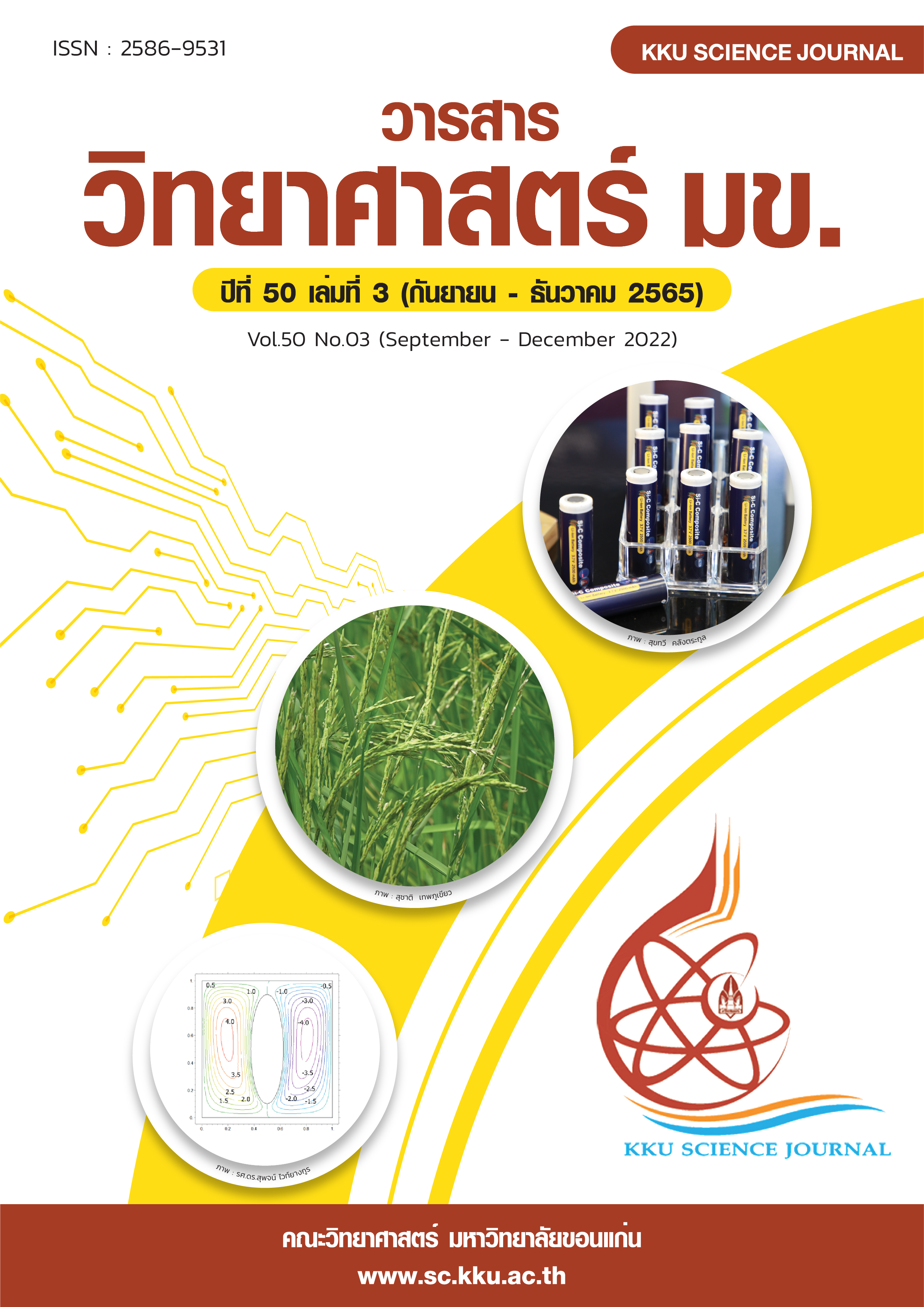การสกัดและฤทธิ์ทางชีวภาพของสารสกัดหยาบกาวไหมจากไหมไทยพื้นบ้าน พันธุ์นางตุ่ย (Bombyx mori L.) ด้วยสารละลายใบกล้วยหมัก
Main Article Content
บทคัดย่อ
ปัจจุบันไหมเป็นที่นิยมเลี้ยงกันเป็นอย่างมากในประเทศไทย โดยเฉพาะอย่างยิ่งทางภาคตะวันออกเฉียงเหนือและเป็นอุตสาหกรรมที่สร้างรายได้สูงให้กับเกษตรกร รังไหมประกอบไปด้วยโปรตีนไฟโบรอิน (fibroin) และเซริซิน (sericin) โดยไฟโบรอินนั้นถูกนำมาทำอุตสาหกรรมสิ่งทอ วิศวกรรมเนื้อเยื่อ และเทคนิคขั้นสูงทางการแพทย์ ส่วนเซริซินหรือกาวไหมนั้นจะไม่ถูกนำมาใช้ประโยชน์แต่ในปัจจุบันพบว่ากาวไหมนั้นมีความสำคัญอย่างมากในอุตสาหกรรมเวชสำอาง ยา อาหาร และทางการแพทย์ เพราะมีฤทธิ์ทางชีวภาพหลากหลาย ดังนั้นงานวิจัยนี้มีวัตถุประสงค์เพื่อหาวิธีลอกกาวไหมโดยหลีกเลี่ยงการใช้สารเคมีในสภาวะที่รุนแรงและทดสอบฤทธิ์ทางชีวภาพของไหมไทยพื้นบ้านสายพันธุ์นางตุ่ย (Bombyx mori L.) โดยการต้มด้วยสารละลายใบกล้วยหมัก แล้วนำไปเปรียบเทียบกับวิธีลอกกาวไหมด้วยการต้มด้วยน้ำกลั่น การต้มด้วย 0.2% (w/v) โซเดียมคาร์บอเนต และวิธีการสกัดหยาบด้วยวิธี autoclave ผลการวิจัยพบว่า การสกัดกาวไหมด้วยสายละลายใบกล้วยหมัก นาน 90 นาทีมีประสิทธิภาพในการลอกกาวไหม (% Degumming) เท่ากับร้อยละ 10.47 และมีค่าใกล้เคียงกับน้ำกลั่น (ร้อยละ 9.50) ากนั้นนำสารสกัดแบบหยาบมาวิเคราะห์ปริมาณโปรตีนด้วยวิธี Bradford assay และวิเคราะห์หาปริมาณสารประกอบฟีนอลิกรวม ปริมาณฟลาโวนอยด์รวม พบว่าวิธีการสกัดหยาบโดยการต้มด้วยสารละลายใบกล้วยหมัก นาน 60 นาที มีปริมาณฟีนอลิกรวมสูงที่สุด คือ 6.293 mg GAE/g DW วิธีการสกัดหยาบโดยการต้มด้วยสารละลายใบกล้วยหมักนาน 30 นาที ปริมาณฟลาโวนอยด์รวมสูงที่สุด คือ 10.589 mg GAE/g DW แล้วศึกษาฤทธิ์ในการต้านสารอนุมูลอิสระด้วยวิธี ABTS assay และวิธี Potassium ferricyanide reducing power assay ผลการวิจัยพบว่า ด้วยวิธี ABTS assay การต้มด้วยสารละลายใบกล้วยหมัก นาน 60 นาที นั้นมีร้อยละการยับยั้งการเกิดออกซิเดชันสูงที่สุด คือ 77.543 ± 2.240 ส่วนสารสกัดด้วยสารละลายใบกล้วยหมัก นาน 30 นาที มี reducing ability มากที่สุดเทียบเท่าวิตามินซีเข้มข้น 245.651 ± 22.184 (µg/ml) จะเห็นได้ว่าการลอกกาวไหมโดยใช้สารละลายหมักใบกล้วยเป็นอีกทางเลือกหนึ่งที่สามารถนำไปสกัดสารออกฤทธิ์ทางชีวภาพจากรังไหมได้
Article Details

อนุญาตภายใต้เงื่อนไข Creative Commons Attribution-NonCommercial-NoDerivatives 4.0 International License.
เอกสารอ้างอิง
กนกพร พลเยี่ยม และสินีนาฏ ศิริ. (2556). การสกัดเซรินจากรังไหม Bombyx mori and Samila Cynthia ricini. ใน: การประชุมวิชาการการวิจัยเพื่อพัฒนาสังคมไทย “การประชุมหาดใหญ่ ครั้งที่ 4”. มหาวิทยาลัยหาดใหญ่, สงขลา. (43-51).
ธัญพรรณ ฮ่อบรรทัด. (2559). ประสิทธิภาพการสกัดเซซินจากเส้นไหมโดยขี้เถ้าเปลือกนุ่นและขี้เถ้าลูกขนุน ใน: การประชุมวิชาการระดับชาติและนานาชาติ “ราชภัฏวิจัยครั้งที่ 4” (กลุ่มวิทยาศาสตร์และ เทคโนโลยี). มหาวิทยาลัยราชภัฏบุรีรัมย์, บุรีรัมย์. (1163-1172).
ธีรธัช อาภรณ์, สาคร ชลธาร และรัตนพล มงคลรัตนาสิทธิ์. (2553). ประสิทธิภาพการลอกกาวไหมอีรี่โดยการ แช่รังไหมในสารละลายขี้เถ้าจากใบกล้วยและสบู่มาตรฐาน. วารสารวิจัยราชมงคลกรุงเทพ 14(2): 104-115.
นงนุช ศศิธร และกาญจนา ลอพงษ์. (2551). การลอกกาวไหมด้วยยางมะละกอ. วารสารวิชาการและวิจัย มทร.พระนคร 2(1): 70–75.
สินีนาฏ ศิริ และกนกพร พลเยี่ยม. (2560). การเพิ่มมูลค่าไหมบ้านและไหมอีรี่ด้วยการพัฒนาเป็นวัสดุปิดแผลที่ ใช้งานได้ด้วยเทคนิคอิเล็กโตรสปินนิง. รายงานวิจัยสาขาวิชาชีววิทยา สำนักวิชาวิทยาศาสตร์, มหาวิทยาลัยเทคโนโลยีสุรนารี.
Aramwit, P., Damrongsakkul, S., Kanokpanont, S. and Srichana, T. (2010).Properties and anti tyrosinase activity of sericin from various extraction methods. Biotechnology and Applied Biochemistry 55(2): 91-98.
Bradford, M.M. (1976). A rapid and sensitive method for the quantitation of microgram quantities of protein utilizing the principle of protein- dye binding. Analytical Bio-chemistry 72(1-2): 248-254.
Cao, T.T. and Zhang, Y.Q. (2016). Processing and characterization of silk sericin from Bombyx mori and its application in biomaterials and biomedicines.Materials Science and Engineering: C 61: 940-952.
Chandra, S., Khan, S., Avula, B., Lata, H., Yang, M.H., Elsohly, M.A. and Khan, I.A. (2014). Assessment of total phenolic and flavonoid content, antioxidant properties, and yield of aeroponically and conventionally grown leafy vegetables and fruit crops: A comparative study. Evidence - Based Complementary and Alternative Medicine 2014: 1-9.
Fan, J.B., Wu, L.P., Chen, L.S., Mao, X.Y., and Ren, F.Z. (2009). Antioxidant activities of silk sericin from silkworm Bombyx mori. Journal of Food Biochemistry 33(1): 74-88.
Jemli, M.E., Kamal, R., Marmouzi, I., Zerrouki, A., Cherrah, Y. and Alaoui, K. (2016). Radical-scavenging activity and ferric reducing ability of Juniperus thurifera (L.), J. oxycedrus (L.), J. phoenicea (L.) and Tetraclinis articulata (L.). Advances in Pharmacological Sciences 2016: 639-656.
Jena, K., Pandey, J. P., Kumari, R., Sinha, A.K., Gupta, V.P., and Singh, G.P. (2018). Tasar silk fiber waste sericin: New source for anti-elastase, anti-tyrosinase and anti-oxidant compounds. International Journal of Bio logical Macromolecules 114: 1102-1108.
Kato, N., Sato, S., Yamanaka, A., Yamada, H., Fuwa, N., and Nomura, M. (1998). Silk protein, sericin, inhibits lipid peroxidation and tyrosinase activity. Bioscience Biotechnology Biochemistry 62(1): 145-147.
Kunz, R.I., Brancalhão, R.M., Ribeiro, L.F., and Natali, M.R. (2016). Silkworm sericin: Properties and biomedical applications. Biomed Research International 2016: 1-19.
Padamwar, M. and Pawar, A. (2004). Silk sericin and its applications: A review. Journal of Scientific and Industrial Research 63: 323-329.
Pearson’s Correlation Coefficient. (2008). In Kirch, W. (Eds.) Encyclopedia of Public Health. Dordrecht: Springer-Verlag. pp. 1090-1091.
Re, R., Pellegrini, N., Proteggente, A., Pannala, A., Yang, M., and Rice-Evans, C. (1999). Antioxidant activity applying an improved ABTS radical cation decolorization assay. Free Radical Biology and Medecine. 26(9-10): 1231-1237.
Sasaki, M., Kato, N., Watanabe, H., and Yamada, H. (2000). Silk protein, sericin, suppresses colon carcinogenesis induced by 1,2-dimethylhydrazine in mice. Silk protein, sericin, suppresses colon carcinogenesis induced by 1,2-dimethylhydrazine in mice. Oncology Reports 7(5): 1049-1052.
Singleton, V.L., Orthofer, R. and Lamuela-Raventós, R.M. (1999). Analysis of total phenols and other oxidation substrates and antioxidants by means of Folin-Ciocalteu reagent. Methods in Enzymology 299: 152-178.
Takasu, Y., Yamada, H., Tsubouchi, K. (2002). Isolation of three main sericin components from the cocoon of the silkworm, Bombyx mori. Bioscience biotechnology and biochemistry 66(12): 2715-8
Tao, W., Li, M., and Xie, R. (2005). Preparation and structure of porous silk sericin materials. Macromolecular Materials and Engineering 290(3): 188-194.
Yun, H., Oh, H., Kim, M.K., Kwak, H.W., Lee, J.Y., Um, L.C. and Lee, K.H. (2013). Extraction conditions of Antheraea mylitta sericin with high yields and minimum molecula weight degradation. International Journal of Biological Macromolecules 52: 59-65.


